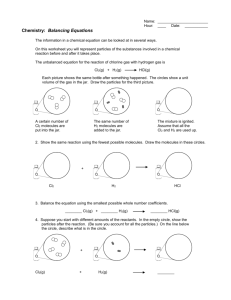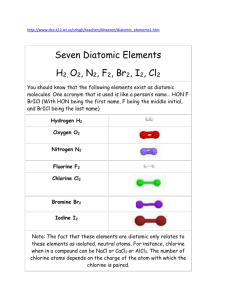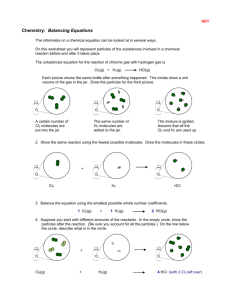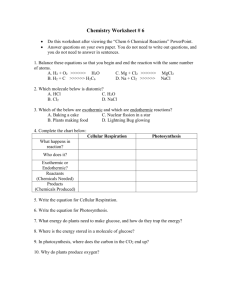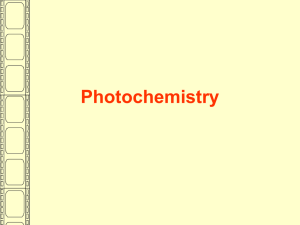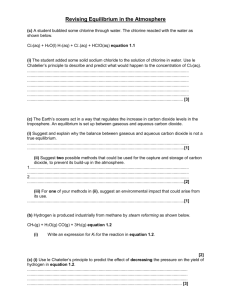here - A-level chemistry
advertisement
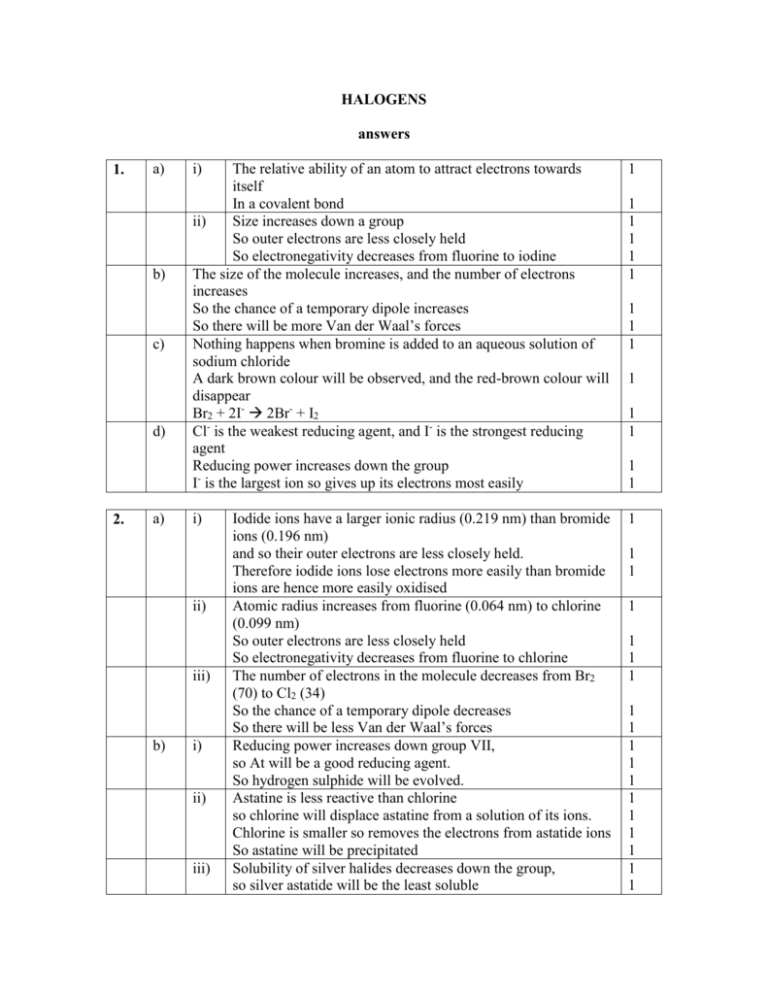
HALOGENS answers 1. a) b) c) d) 2. a) i) The relative ability of an atom to attract electrons towards itself In a covalent bond ii) Size increases down a group So outer electrons are less closely held So electronegativity decreases from fluorine to iodine The size of the molecule increases, and the number of electrons increases So the chance of a temporary dipole increases So there will be more Van der Waal’s forces Nothing happens when bromine is added to an aqueous solution of sodium chloride A dark brown colour will be observed, and the red-brown colour will disappear Br2 + 2I- 2Br- + I2 Cl- is the weakest reducing agent, and I- is the strongest reducing agent Reducing power increases down the group I- is the largest ion so gives up its electrons most easily 1 i) 1 ii) iii) b) i) ii) iii) Iodide ions have a larger ionic radius (0.219 nm) than bromide ions (0.196 nm) and so their outer electrons are less closely held. Therefore iodide ions lose electrons more easily than bromide ions are hence more easily oxidised Atomic radius increases from fluorine (0.064 nm) to chlorine (0.099 nm) So outer electrons are less closely held So electronegativity decreases from fluorine to chlorine The number of electrons in the molecule decreases from Br2 (70) to Cl2 (34) So the chance of a temporary dipole decreases So there will be less Van der Waal’s forces Reducing power increases down group VII, so At will be a good reducing agent. So hydrogen sulphide will be evolved. Astatine is less reactive than chlorine so chlorine will displace astatine from a solution of its ions. Chlorine is smaller so removes the electrons from astatide ions So astatine will be precipitated Solubility of silver halides decreases down the group, so silver astatide will be the least soluble 1 1 1 1 1 1 1 1 1 1 1 1 1 1 1 1 1 1 1 1 1 1 1 1 1 1 1 1 1 1 So it will not dissolve in aqueous ammonia 1 3. a) b) c) d) 4. a) b) c) 5. a) b) c) d) e) 6. a) b) i) ii) iii) S, SO2, H2S I2 Iodine - a purple vapour Hydrogen sulphide – a gas smelling of rotten eggs iv) Sulphuric acid behaves as an acid in the formation of hydrogen iodide v) H2SO4 + 8H+ + 8e H2S + 4H2O Bromide ion, Bri) A white precipitate ii) A cream precipitate The white precipitate will dissolve in dilute aqueous ammonia The cream precipitate will not dissolve in dilute aqueous ammonia but will dissolve in concentrated aqueous ammonia 3 1 1 1 1 An electron acceptor Chloride ion, ClH2SO4 + Cl- HSO4- + HCl Iodide ion, I2I- I2 + 2e H2SO4 + 8H+ + 8e H2S + 4H2O H2SO4 + 8H+ + 8I- H2S + 4H2O + 4I2 1 1 1 1 1 1 1 Cl2(g) + H2O(l) == HCl(aq) + HClO(aq) The green colour is the dissolved chlorine, Cl2(aq) The Cl2 disproportionates Cl2(aq) + 2OH-(aq) Cl-(aq) + ClO-(aq) + H2O(l) Hence the green colour disappears Cl-(aq) + ClO-(aq) + 2H+(aq) Cl2(aq) + H2O(l) ClO-(aq), usually in the form of NaClO Oxidation number of Cl = +1 1 1 1 1 1 1 1 1 A brown colour will be seen in the solution Cl2 + 2I- 2Cl- + I2 Chlorine is an oxidizing agent i) Mistake in question – should say sodium hydroxide Cl2(aq) + 2OH-(aq) Cl-(aq) + ClO-(aq) + H2O(l) ii) Cl2(g) + 2e 2Cl-(aq) Cl2(g) + 6H2O(l) 2ClO3-(aq) + 12H+(aq) + 10e 6Cl2(g) + 6H2O(l) 2ClO3-(aq) + 12H+(aq) + 10Cl-(aq) 3Cl2(g) + 3H2O(l) ClO3-(aq) + 6H+(aq) + 5Cl-(aq) in alkaline solution 1 1 1 1 1 1 1 1 1 1 1 2 1 3Cl2(g) + 3H2O(l) + 6OH-(aq) ClO3-(aq) + 6H+(aq) + 6OH-(aq) + 5Cl-(aq) 3Cl2(g) + 3H2O(l) + 6OH-(aq) ClO3-(aq) + 6H2O(l) + 5Cl-(aq) 3Cl2(g) + 6OH-(aq) ClO3-(aq) + 6H2O(l) + 5Cl-(aq) 1 7. From experiment 1: Bromine and iodine are produced So mixture contains iodide and bromide ions Cl2(g) + 2I-(aq) 2Cl-(aq) + I2(s) black precipitate Cl2(g) + 2Br-(aq) 2Cl-(aq) + Br2(g) orange-brown fumes From experiment 2: AgBr and AgI are formed. Ag+(aq) + Br-(aq) AgBr(s) Ag+(aq) + I-(aq) AgI(s) Total mass of AgBr and AgI = 0.902 g AgBr is removed on addition of concentrated aqueous ammonia AgBr(s) + 2NH3(aq) [Ag(NH3)2]+(aq) + Br-(aq) Mass of AgI only = 0.546 g So mass of AgBr = 0.902 – 0.546 = 0.356 g Mass of I = 127/235 x 0.546 = 0.295 g Mass of Br = 80/188 x 0.356 = 0.151 g % of I = 0.295/0.545 x 100 = 54.1% % of Br = 0.151/0.545 x 100 = 27.8% 2 2 1 1 1 1 1 1 1 2 2

